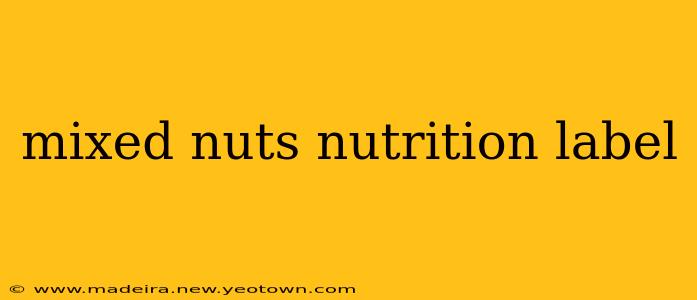Mixed nuts. The crunchy, satisfying snack that’s both delicious and surprisingly good for you. But have you ever really looked at the nutrition label? It's a tiny window into a world of fats, proteins, and vitamins. Let's crack open this label and unravel the nutritional secrets hidden within those seemingly simple kernels.
Imagine this: you're reaching for a handful of mixed nuts – almonds, cashews, walnuts, pecans, maybe even some pistachios. The bag crinkles satisfyingly, promising a tasty treat. But before you dive in, that nutrition label holds the key to understanding exactly what you're consuming.
What are the main components of a mixed nuts nutrition label?
A typical mixed nuts nutrition label will highlight several key components:
-
Serving Size: This is crucial. It's usually a small handful, often around 1 ounce (approximately 28 grams). Keep this in mind – the entire nutritional breakdown is based on this serving size. Eating more will naturally increase the calories and other nutrients proportionally.
-
Calories: This tells you the energy content of a serving. Mixed nuts are calorie-dense, meaning they pack a lot of energy into a small amount of food. This is both a benefit (sustained energy) and something to be mindful of (portion control).
-
Total Fat, Saturated Fat, Trans Fat: Nuts are naturally high in fat, but much of this is healthy unsaturated fat, crucial for heart health. Look at the types of fat. Saturated and trans fats should be kept low in your overall diet.
-
Cholesterol: Nuts generally contain very little to no cholesterol.
-
Sodium: This varies greatly depending on whether the nuts are salted or unsalted. Opt for unsalted varieties to keep sodium intake lower.
-
Total Carbohydrate, Dietary Fiber, Sugars: Nuts are relatively low in carbohydrates, but the fiber content is a significant contributor to their health benefits. Fiber aids digestion and promotes satiety.
-
Protein: Nuts are a decent source of protein, contributing to feelings of fullness and muscle repair.
-
Vitamins and Minerals: The label will often list vitamins like Vitamin E and minerals like magnesium and potassium, showcasing the nutritional richness of nuts.
What are the health benefits of eating mixed nuts?
The nutritional profile of mixed nuts makes them a power-packed snack. They offer a wealth of health benefits:
-
Heart Health: The unsaturated fats in nuts contribute to lowering LDL ("bad") cholesterol levels, reducing the risk of heart disease.
-
Brain Function: Certain nuts, such as walnuts, are rich in omega-3 fatty acids, vital for brain health and cognitive function.
-
Weight Management: Despite their calorie density, nuts can aid in weight management. Their high fiber and protein content contribute to feelings of fullness, reducing overall calorie intake.
Are mixed nuts good for weight loss?
This is a common question. While nuts are calorie-dense, their high fiber and protein content can promote satiety, making you feel fuller for longer and potentially reducing your overall calorie consumption. However, moderation is key. Stick to the recommended serving size to avoid exceeding your daily calorie goals.
Are all mixed nuts created equal?
No! The nutritional content varies slightly depending on the specific nut varieties included in the mix. A mix heavily weighted towards almonds will have a different profile than one predominantly composed of cashews. Check the ingredients list to see the proportion of each nut type.
What should I look for when choosing mixed nuts?
Look for unsalted varieties to reduce sodium intake. Check the ingredients list to avoid added sugars, oils, or preservatives. Opt for brands that prioritize quality and source their nuts responsibly.
So, the next time you reach for a bag of mixed nuts, take a moment to appreciate the nutritional powerhouse you’re about to enjoy. Remember the label's guidance, savor each bite mindfully, and reap the rewards of this healthy and delicious snack!

